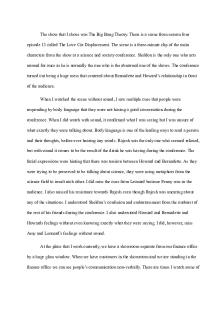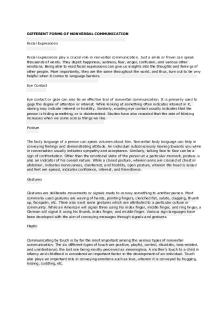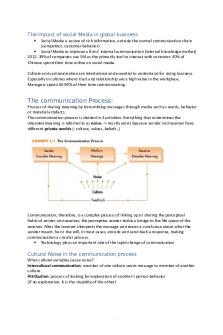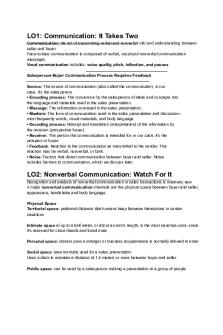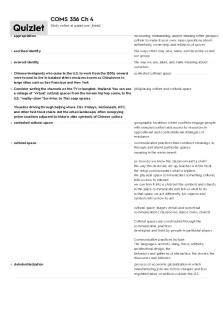Chapter 4 - Nonverbal Communication PDF

| Title | Chapter 4 - Nonverbal Communication |
|---|---|
| Author | Isis Medina |
| Course | Communication and Community |
| Institution | San Diego State University |
| Pages | 2 |
| File Size | 45.3 KB |
| File Type | |
| Total Downloads | 34 |
| Total Views | 189 |
Summary
Professor Fallon...
Description
Chapter 4 - Nonverbal Communication Nonverbal communication conveys important interpersonal and emotional messages Involuntary Ambiguous Credible Functions of Nonverbal Comm Confirms our verbal Contradicts - sarcasm Complements - Incomplete messages Conveys Meaning - Reinforcing - Substituting ● Nonverbal takes place of verbal ○ Waving, flipping someone off, gifts, hugs, kisses, pats on the back - Contradicting - Complementing Influences Other People - Smiling at someone and they smile back - RBF Regulates Conversation Flow - Know when to start/stop talking Affects Relationships - Holding hands - Kiss - Hug - Arms around each other - Proximity - PDA Expresses Our Identities - How we dress, how we stand, how we act Types of Nonverbal Comm - Gestures ● Adaptors ○ Comforting ○ Nonverbal gestures that convey nervousness ● Emblems ○ Have an agreed upon meaning ○ Substitute verbal comm ○ Varies by culture ● Illustrators ○ “Phone call” “typing a keyboard” “guitar playing”
-
Head movements and Posture ● Standing up straight, shoulders back Eye Contact ● Paying attention, serious, respect, ● Regulate interaction ● Monitor nonverbal communication from others ● Signal cognitive activity ● Expres engagement ● Flirt
4.2.1 Facial Expressions Expressing our emotions Consistent throughout cultures - Haptics ● functional/ professsional ● social/polite ● friendship/warmth ● love /intimacy ● Sexual arousal ● Control ● Violence ● Celebration - Vocalics ● Personality expresses largely through our voice - Proxemics ● We are most uncomfortable when someone enters our personal space - Territoriality - Chronemics ● Culturally influenced/ bound - Personal Presentation and Environment ● What we do or don’t do with our hair ● How we choose to present ourselves is largely nonverbal ● You don’t tell people you’re confident/happy, you express it nonverbally ● The goal was to make sure that this ermainds a white mans country we jsut...
Similar Free PDFs
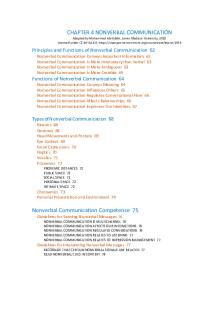
Chapter 4 Nonverbal Communication
- 19 Pages

6 - Nonverbal Communication
- 1 Pages

CH 5 HW: Nonverbal Communication
- 2 Pages
Popular Institutions
- Tinajero National High School - Annex
- Politeknik Caltex Riau
- Yokohama City University
- SGT University
- University of Al-Qadisiyah
- Divine Word College of Vigan
- Techniek College Rotterdam
- Universidade de Santiago
- Universiti Teknologi MARA Cawangan Johor Kampus Pasir Gudang
- Poltekkes Kemenkes Yogyakarta
- Baguio City National High School
- Colegio san marcos
- preparatoria uno
- Centro de Bachillerato Tecnológico Industrial y de Servicios No. 107
- Dalian Maritime University
- Quang Trung Secondary School
- Colegio Tecnológico en Informática
- Corporación Regional de Educación Superior
- Grupo CEDVA
- Dar Al Uloom University
- Centro de Estudios Preuniversitarios de la Universidad Nacional de Ingeniería
- 上智大学
- Aakash International School, Nuna Majara
- San Felipe Neri Catholic School
- Kang Chiao International School - New Taipei City
- Misamis Occidental National High School
- Institución Educativa Escuela Normal Juan Ladrilleros
- Kolehiyo ng Pantukan
- Batanes State College
- Instituto Continental
- Sekolah Menengah Kejuruan Kesehatan Kaltara (Tarakan)
- Colegio de La Inmaculada Concepcion - Cebu



